The lawn's starting to lose color for winter, which is fairly normal. It's still the greenest in the area, but I'm going to try spraying a little iron on it to put that into root storage for spring. That should accelerate spring green-up, as well as change the color a bit.
I sprayed yesterday with kelp, humates, and soil conditioner as well and that seemed to change the color to a bit darker this morning.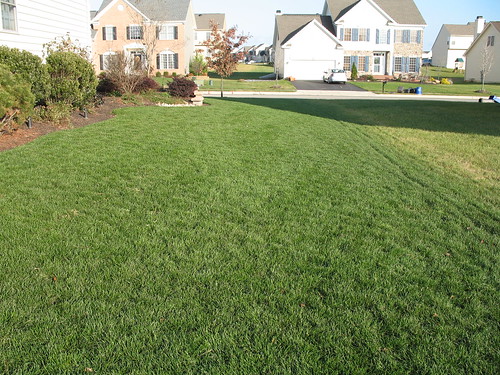
Wednesday, December 2, 2009
December Photo
Tuesday, December 1, 2009
Kentucky Bluegrass Winter Seeding
I've done the first winter seeding (of three) of the lawn, including lightly scratching the soil and distributing seed by hand at about 1 pound per thousand.
Winter, or frost, seeding is done after soil temperatures drop under fifty (ours are actually about 48 right now, but descending fast). The seed won't germinate until spring, although normal freeze-thaw cycles will carry it into the soil fairly effectively. Unless the spring is quite dry, it doesn't need to be watered, but will require some coddling the following summer until it matures--usually the following fall.
Frost seeding isn't as effective as a fall seeding at the appropriate time (around Labor Day or a bit earlier here). However, it's more successful than a spring seeding would be, since I don't have to worry about hitting the correct window of soil temperatures. The seed will sprout the first instant it can.
I tend to divide the seedings into three--December, which is put down on scratched soil, as well as February and again in March, which are scattered as the soil is still frozen at that time. However, one seeding would be quite sufficient.
The mix I chose is a bit different this year:
Midnight II--a Compact-Midnight type. This was in my original lawn, and makes up 33% of the mix this time. This is one of the more available elite bluegrasses, and has been in continuous and heavy production for ages.
Brilliant--a Compact-America type, 20% of the mix. This is to replace the Moonlight in the original lawn which is now extremely difficult to get in sod quality from my preferred suppliers. I have no experience with this grass, but the color should be comparable.
Prosperity--A Compact type, 20% of the mix. This is to replace the Bedazzled in the original lawn, which is similarly difficult to get. I used this on the back line and it's slightly darker than Bedazzled, although not enough to notice.
Blueberry--A Compact type, 13% of th mix. I'm testing this as according to reports it's quite dark and a beautiful grass.
Moonbeam--A Compact type, 13% of the mix. This is another test grass, and again, quite dark.
To keep the darker colored grasses from being obvious, I also seeded a band around the repaired areas. The mix should blend fairly well, but if not I'll overseed with Blueberry and Moonbeam next fall across the entire lawn.
Monday, November 23, 2009
Final Fertilizer for the Lawn
I winterized the lawn today using Vigoro Super Green (35-0-5). It has a urea base, and about 1/3 of the nitrogen is slow release. As such, although temperatures are a bit high, it needs to go now. Urea needs several days to process in the soil before thinking about becoming available to the lawn, and by the time that happens our temperatures are projected to drop sharply.
Here's the entire list of items used on the lawn this year. Yes, the final total across the whole lawn is over 9,000 pounds...
| Date | N | P | K | Iron | Organics | Other Notes |
| 2/18/2009 | 0.85 | 0.43 | 0.43 | | 42.7 | Dog Food |
| 3/1/2009 | 1.03 | 0.41 | 0.31 | 0.82 | 20.6 | Milorganite, Sul-Po-Mag |
| 3/14/2009 | 0.35 | 0.14 | 0.29 | | 20.0 | Alfalfa, Sugar |
| 3/21/2009 | 1.38 | 0.54 | 0.33 | | 83.3 | Corn Meal |
| 3/28/2009 | 0.10 | 0.00 | 0.20 | | 10.0 | Kelp Meal |
| 4/4/2009 | 1.50 | 0.21 | 0.43 | | 21.4 | Soybean Meal |
| 4/18/2009 | 0.14 | 0.06 | 0.06 | | 7.8 | Dog Food, Corn Meal |
| 4/21/2009 | 1.71 | 0.61 | 0.17 | 1.97 | 30.9 | Milorganite, Ironite |
| 4/30/2009 | 0.70 | 0.24 | 0.10 | 0.93 | 12.0 | Milorganite, Ironite |
| 5/15/2009 | 1.47 | 0.48 | 0.27 | 2.16 | 24.0 | Milorganite, Ironite |
| 5/29/2009 | 0.82 | 0.23 | 0.12 | | 11.7 | Soybean Meal |
| 6/3/2009 | 0.75 | 0.30 | 0.00 | 0.71 | 15.0 | Cu, Zn, Mn, Fe, Milorganite |
| 6/10/2009 | 0.91 | 0.34 | 0.36 | 1.80 | 58.3 | Corn Meal, Kelp, FeSO4 |
| 6/25/2009 | 0.90 | 0.36 | 0.00 | 0.72 | 18.0 | Milorganite |
| 7/8/2009 | 1.73 | 0.69 | 0.20 | 1.32 | 68.0 | Corn, Milorganite, FeSO4 |
| 7/22/2009 | 1.62 | 0.52 | 0.16 | 0.42 | 26.0 | Soybean meal, Milorganite |
| 7/31/2009 | 1.41 | 0.54 | 0.34 | 0.41 | 67.4 | Corn, Milorganite, Kelp |
| 8/8/2009 | 1.86 | 0.71 | 0.23 | 0.72 | 83.0 | Corn, Milorganite, Compost |
| 8/15/2009 | 0.83 | 0.30 | 0.20 | 0.21 | 50.0 | Corn, Fe3O4, FeSO4 |
| 8/23/2009 | 1.97 | 1.36 | 0.36 | 0.41 | 62.3 | Corn, Milorganite, Starter |
| 9/1/2009 | 2.13 | 1.29 | 0.28 | 0.34 | 21.4 | Soybean Meal, Starter |
| 9/13/2009 | 2.06 | 1.27 | 0.41 | 0.25 | 21.4 | Soybean Meal, Starter |
| 9/26/2009 | 1.51 | 1.30 | 0.24 | 0.63 | 15.4 | Milorganite, Starter |
| 10/6/2009 | 0.77 | 0.31 | 0.00 | 0.62 | 15.4 | Milorganite |
| 10/14/2009 | 1.36 | 0.98 | 0.11 | 0.72 | 18.0 | Milorganite, Starter |
| 10/22/2009 | 0.77 | 0.31 | 0.00 | 0.62 | 15.4 | Milorganite |
| 10/29/2009 | 1.47 | 0.75 | 0.38 | 0.72 | 18.0 | Milorganite, Starter |
| 11/12/2009 | 0.90 | 0.36 | 0.00 | 0.72 | 18.0 | Milorganite |
| 11/17/2009 | 2.45 | 1.07 | 0.46 | 0.33 | 306.4 | Leaves 2,145 pounds |
| 11/23/2009 | 1.35 | 0.00 | 0.19 | 0.00 | 0.0 | Vigoro Super Green |
| | | | | | | |
| Total per K ft: | 36.80 | 16.11 | 6.64 | 17.55 | 1179.8 | 9087 active organic total |
Final Fertilizer for the Gardens
I put down 108 pounds of Milorganite today to increase the organic levels (54 pounds per thousand). That's the last feeding for the garden.
Here's the entire list of what's gone down this year:
| Date | N | P | K | Iron | Organics | Notes |
| 2/21/2009 | 0.90 | 0.36 | 0.00 | 0.72 | 18.0 | Milorganite |
| 3/7/2009 | 1.61 | 0.23 | 0.46 | 23.0 | Soybean Meal | |
| 3/21/2009 | 0.41 | 0.16 | 0.10 | 25.0 | Corn Meal | |
| 3/28/2009 | 0.73 | 0.25 | 0.83 | 35.0 | Alfalfa, Kelp | |
| 4/4/2009 | 1.65 | 0.23 | 0.47 | 23.5 | Soybean Meal | |
| 4/21/2009 | 1.50 | 0.60 | 0.00 | 1.20 | 30.5 | Milorganite |
| 5/30/2009 | 0.88 | 0.25 | 0.00 | 12.5 | Soybean Meal | |
| 6/25/2009 | 0.90 | 0.36 | 0.00 | 0.72 | 18.0 | Milorganite |
| 7/20/2009 | 1.40 | 0.40 | 0.20 | 20.0 | Soybean Meal | |
| 8/3/2009 | 0.90 | 0.36 | 0.00 | 0.72 | 18.0 | Milorganite |
| 9/13/2009 | 3.15 | 2.39 | 0.60 | 25.0 | Starter, Soybean Meal | |
| 10/10/2009 | 3.20 | 2.61 | 0.35 | 1.44 | 36.0 | Starter, Milorganite |
| 10/26/2009 | 1.62 | 2.16 | 1.08 | 0.00 | Starter | |
| 11/11/2009 | 3.15 | 2.52 | 0.90 | 1.44 | 36.0 | Starter, Milorganite |
| 11/23/2009 | 2.70 | 1.08 | 0.00 | 2.16 | 54.0 | Milorganite |
| Total per K ft: | 24.70 | 13.96 | 4.99 | 8.40 | 375.5 | 751 active organic total |
Monday, November 16, 2009
Still More Leaves
I've finished the lawn--with 2,000 pounds of leaves in 97 bags, or a cube 8 feet on a side (and a bit).
Any remaining stock will go to increasing the leaf mulch on the drier southern face, plus repairing the soil in the areas the Township damaged and still hasn't fixed (on day 12 and still going!)
However, any remaining stock is going to be limited. Last weekend's storm took down most of the remaining leaves, and I expect about 20 more bags before the end of leaf season.
Thursday, November 12, 2009
The Last of the Milorganite
For the season, anyway! I put down 108 pounds over 6,000 square feet (about 18 pounds per thousand), and went heavily through the Township-damaged areas. I'll follow up with photos of those when I can face them...
Normally I'd publish my entire year of organic additions, but I'll hold off until the leaves are done. I'm still importing them at a fairly high rate.
The Winterizer is yet to go, but that has to wait for soil temperatures to fall under 40. So far, that looks like it won't happen for some time yet.
More Leaves
I've applied around 1,750 pounds of leaves to the lawn and I'm close to 80% complete at this point. The first areas of application are already invisible even applying at nearly 300 pounds per thousand. After a short period, the leaf litter breaks down into black organic matter that's invisible on the soil.
My current estimate is around 2,000 pounds of leaves (a full ton!) to complete the property. That should raise organic matter about half a percent in the soil.
Wednesday, November 4, 2009
Roses in November! Bonus Photo!
I put in a Double Knockout rose in the back, and performance so far has been spectacular. I was careful to organically prepare the soil with two handfuls of cracked corn and two handfuls of alfalfa hay while planting, plus I've applied Milorganite, soybean meal, and large amounts of additional alfalfa throughout the season. For some reason, roses seem to love alfalfa. I also spray the bush and surrounding soil with liquid iron, kelp extract, and a small amount of humic acid. This rose opened November first. Today is the fourth, we've had six or seven frosts, and the rosebush just keeps blooming. There are fifty more on the bush that look just like this...and no, I did absolutely no touching up of this image.
This rose opened November first. Today is the fourth, we've had six or seven frosts, and the rosebush just keeps blooming. There are fifty more on the bush that look just like this...and no, I did absolutely no touching up of this image.
Mulching Leaves on Your Lawn
In the past few weeks I've tapped two other properties of leaves to add to my own--with permission, of course. Both are kind enough to bag the leaves for me so I don't have to do it, and I'd like to extend my thanks (you know who you are).
So far, I've finished around 60% of the lawn and applied approximately 1,200 pounds of leaves (with some cut grass in the bags as well). I'll require a total of 1 ton of leaves, which works out to 285 pounds per thousand square feet.
So what do leaves do? They raise the organic matter percentage in the soil, provide fall food for your worms and micro-arthropods living in your soil, encourage bacterial and fungal activity in the soil, and mulch the soil for winter. Lawns that have been leaf mulched will retain their green color further into winter, green up faster in spring, and generally show greater health than lawns that receive no mulching.
How much should you use? Close to 300 pounds per thousand square feet disappears into the grass in a few days if well-chopped, but applications certainly do not have to be made at that rate. This study shows the results of mulching 150 to 450 pounds of leaves into the soil, and effects are generally excellent.
But isn't leaf litter ugly? Well, yes. The above study states that leaf litter at the highest application resulted in leaves still left on the lawn in spring. However, if you have a rotary mower it becomes easy to render the leaves invisible. With the very large amount I'm using, I mow slowly four times over the area to reduce the leaves to bits smaller than the nail on my pinky (and I have small hands!) By the time I complete the task, almost no visible litter remains--99% has fallen into the grass and becomes invisible. The remaining 1% disappears with the next rainfall.
What's the NPK ratio of leaves? Don't worry about it. Trees extract almost all the chlorophyll and nitrogen and place it in root storage for the winter. There is a small amount of phosphorus in the leaves, so mulching them is better than allowing rainwater to percolate through them while they sit on the street (my other post from today mentions eutrophication; leaves are one source of phosphorus that enters our waterways). Potassium levels are fairly low. The reason leaves are mulched isn't to feed the lawn but instead to provide additional organic material for the soil.
I've Been Busy
Whew, sorry for the posting delay! I've applied 2 more applications of starter fertilizer, bringing my calculated phosphorus amount to 25 PPM. If that's correct, even at the pH of the lawn soil (7.2), I'm exactly at optimal phosphorus levels.
Please note that starter fertilizer should only be added after a soil test that shows you need it. Excess phosphorus can leach into water sources, causing eutrophication of lakes and streams. Eutrophication means that algae growth increases, oxygen levels in the water drop because of bacterial action, and fish have a difficult time surviving.
Many soils have sufficient phosphorus levels and won't require enhancement. Mine, however, did not. The lawn density has increased amazingly from rebalancing the soil for the final time this year and I'll be certain to take photos.
I've also applied Milorganite four times for a total of around 400 pounds, or approximately 60 pounds per thousand. That should help raise the organic matter tests for next year, as well as increase the iron above the 1.4 PPM test. However, the soils are still visibly iron-short and require spray applications to maintain color--I prefer Bonide #299, but any iron source will do.
I've also mulched large amounts of leaves into the lawn, but if you read the other post from today you already know that.
Sunday, September 27, 2009
The First of the Fall Milorganite
I've fed with 108 pounds of Milorganite (15.6 pounds per thousand square feet) to start the fall feeding on the lawn. I can certainly use the iron, as well.
This year, Milorganite continues to be added every two weeks either through the end of October or beginning of November, depending on how the weather plays out.
I've passed well over 5,000 pounds of material for the year so far, and I'm approaching 800 pounds per thousand square feet.
Friday, September 25, 2009
The Last of the Boron
I sprayed the lawn with the last of the boron for the year, one teaspoon per thousand square feet. That should be enough to raise my boron levels from 0.4 PPM to around 0.8 PPM.
Boron's role in plants isn't clearly understood. It does help meristem cells differentiate into blade and root cells. Lacking it, the cells elongate but don't differentiate. Grasses aren't particularly sensitive to boron deficiency, but it's always best to adjust micronutrients into the optimal range if you're comfortable doing so.
Boron is also the touchiest of the micronutrients. 0.4 PPM is slightly deficient, 0.8 PPM is optimal, and sensitive plants will begin showing toxicity symptoms around 1.0 PPM. Only add boron after a soil test shows that your soil is deficient.
Tuesday, September 22, 2009
Starter Fertilizer
It looks like rain out there, so I put down 21 pounds of starter across the lawn (about 3.5 pounds per thousand). My soil test last spring came back at 9 ppm phosphorus, which is a touch low. I'm hoping to increase that into the 12 to 15 range by next year, which will be sufficient for good growth.
I'd use bone meal, but I have trouble getting enough and the starter fertilizer is a much more rapid source.
Phosphorus is used for energy transport and storage within the plant cell, as well as being an integral part of the RNA and DNA molecules. In flowering plants, it assists with flower production, although that isn't an issue on the grass. I did, however, add some to the gardens as well to work in by next spring.
Friday, September 18, 2009
It's Been A While
 Sorry for the delay folks.
Sorry for the delay folks.
Here's a recent image of the lawn. I think the iron levels are finally starting to come up! This is post adding 4 pounds of sprayed iron sulfate from Bonide (the bagged, powdered stuff you can get in most stores). A week later, the color still hasn't faded.
The last 350 pounds of corn went down August 25th with a bit of Milorganite. So far in September I've fed twice with 150 pounds of soybean meal. I've moved 5,022 pounds of organic material this year, or about 775 pounds per thousand.
For the remainder of the year, Milorganite is the heavy-hitter. It works better as soil temperatures cool a bit.
Saturday, August 15, 2009
Um...and Again
I just dropped another 350 pounds of cracked corn on the lawn and the birds, at least, are pleased with me.
This is the second last drop at this level for the year--in fact, for a good long time, if not forever.
I just passed 2 tons of material on the lawn and gardens this year, or well over 650 pounds per thousand.
Tuesday, August 11, 2009
I Fed Again...
We're moving toward September, so down went another 350 pounds of corn meal, 3 bags of Milorganite, and about 40 pounds of leftover compost (scattered very thinly across the property). That works out to about 80 pounds per thousand.
Fortunately, this is the last year. My back hurts.
Wednesday, August 5, 2009
An Updated Image
It's been quite some time since I posted an image of the lawn. Things are doing well, barring the occasional bit of P. annua and P. trivialis.
As always, click to embiggen!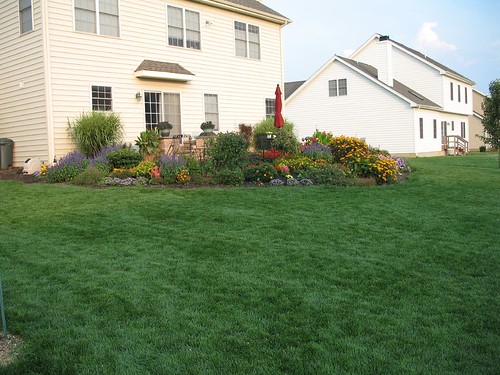
Sunday, August 2, 2009
Still More Feeding and Compost Update
We're getting a large amount of rain this week, so I put down another 350 pounds of cracked corn and 72 pounds of Milorganite yesterday. I fed the swale again to prepare it for fall.
That's down to another 1.3 pounds of nitrogen, but I'm adding it more for the soil changes than feeding the lawn.
The composting is working well in the free garbage can. The first load was very heavy on torn up sod, so it didn't break apart very well. I added more shredded junk mail and garden trimmings and the pile is now at 144°. Hopefully that will break apart the sod a little more.
At this rate, I should have a load of compost by the end of September, just in time to start composting the fall leaves.
Wednesday, July 22, 2009
Another Heavy Feeding
Summer isn't even thinking about winding down yet, but organics take a while to work in. I added 110 pounds of soybean meal and another 72 pound of Milorganite to the lawn over 7,000 square feet--I usually don't feed the swale, but I've done considerable work back there and it could use the energy to spread.
For those of you playing along at home, that's 1.6 pounds of nitrogen, which is a very heavy feeding for July. That's on top of the 1.7 pounds that went down at the beginning of the month. Fortunately there's no chance of burning it, and the number of worms is exploding again.
This is the last year I'm going to be striking it this heavily.
I have to take photos of this. The lawn resembles June more than July (however, so does the weather around here), and is an incredible dark green with an aquamarine overtone. The color is more from the iron than the feeding, however.
Saturday, July 18, 2009
Beginning Composting
Our township gave away (well, paid for by my taxes) 95 gallon yard waste containers. My mother had a 65 gallon container with a small hole in the bottom which she wanted to get rid of, so I took it.
An hour later with the drill, it looks like it was used for buckshot practice by somebody who can't aim very well. I can't tell you how many holes are in it...one every inch to an inch and a half all over the container.
I tossed in some leftover sod after bashing off the soil and ripping it apart, followed it up with a pile of lawn weeds and a bit of shrub cuttings, and shredded some plain paper junk mail to get some browns into the pile. Half an ounce of molasses got added with some water as well to start the process.
I'll initially turn the pile in the next week to mix everything once I'm done weeding the gardens again, but after that it's going to be relatively unturned. Every once in a while I may get around to it.
I'm hoping that, filling it by August, I have compost next spring.
Wednesday, July 8, 2009
More Corn and Milorganite
I fed with another 50 pounds per thousand square feet of cracked corn today, and added another 18 pounds of Milorganite on top of that. Hopefully the Milorganite will repel the birds and rabbits a bit.
Our weather is holding more like early June than July and we're still getting sufficient rain, although June's deluge seems to have stopped at least temporarily. While I wouldn't normally feed that heavily in July, this year won't be an issue.
Looking at the soil condition lately, this is the last year I need to apply at these incredibly high rates. The soil's finished transforming from solid clay to something much more friable. Technically, I could stop now, but there's no issue with continuing through the end of the season.
I do need to update the photos as the lawn is continuing to darken from the iron applications. I'll wait until I mow to do that.
Sunday, June 21, 2009
Saturday, June 20, 2009
Image Update
I took this photo about 20 minutes before sunset tonight. I added 2 pounds per thousand of ferrous sulfate just before it rained, and sprayed the lawn a grand total of three times for 5 ounces of iron per thousand total as a foliar application.
That is a lot of iron, but once temperatures during the day start rising above 80 I'll be less able to add it without burning. That will probably be the last soil application until late August. By the numbers, 11 pounds of iron per thousand square feet should have raised my iron levels to around 45 parts per million, but my soil's slightly alkaline state will enable it to bind most of that.
As always, click the photo to embiggen!
Saturday, June 13, 2009
Chelated Iron
I picked up some Bonide #299 Liquid Iron Complex quite cheaply (about a third the usual price), so I've applied that to the lawn.
The recommended rate for bluegrasses is 2 to 6 ounces per thousand square feet in enough water to apply it, and then spray to runoff. I diluted 2 ounces in 1 gallon of water and found it made a slightly thin spray. Next time I'll dilute half that in a gallon and go 500 square feet.
The hydrangea, which was a touch yellow, is showing a response in just a few hours. The grass should take 1 to 4 days to show any change at all. Since I went at 1/3 the normal rate, I may also have to apply more to achieve the color I want.
Wednesday, June 10, 2009
More Corn and Kelp
Summer's about to heat up here in PA (if it ever stops raining), so I've added 50 pounds per thousand of cracked corn and 8 pounds per thousand kelp meal to help prepare for it, feed the lawn over summer, and help fight the fungi from all the rain we've had.
It looks like my ferrous sulfate will arrive Friday, so I'll be soil drenching on Saturday.
Monday, June 8, 2009
Iron Oxide
Since iron oxide (Fe3O4) is so incredibly cheap, I've added 20 pounds over six thousand square feet, or about 3.3 pounds per thousand square feet. I'll report back later on the results.
One minor note is that if you can get it in granular form somehow, do so. The powdery stuff goes everywhere, even when mixed with Milorganite to even out the distribution.
Sunday, June 7, 2009
Thuja standishii x plicata (Green Giant Thuja) Update
The new Thuja, which I had estimated at a six inch growth rate this year, have grown considerably in two months already. The winner is a bit over 24 inches of increased height, the laggard is around eight inches taller. Since growth continues until August or so, these may get considerably taller than they already are.
Right now, width is fairly stable but increasing slowly.
Friday, June 5, 2009
Milorganite vs Ironite
I keep seeing this search and thought about it for a bit. It's a good question.
First, the basics. Milorganite is 5-2-0 fertilizer with 4% iron and a few micronutrients in it. Ironite is 1-0-1 additive with 4.5% iron and a host of micronutrients in it. I hesitate to call Ironite a fertilizer when it has such low numbers.
So which should you use? What are you trying to do and what do you need?
For standard lawn feeding, the Milorganite is definitely the better choice. The iron in it is sufficient to green your lawn without burning it, and the nitrogen is organic and also will not burn.
If you have chlorosis (an iron shortage) or a known shortage of the other nutrients in Ironite, the Ironite is the superior choice. The nitrogen is water-soluble, but there isn't much at only 1%. The iron, at 4.5%, is slightly superior to Milorganite and will green the lawn faster.
To determine if you have a shortage of the micronutrients in Ironite, you should have your soil tested.
Many people state that Ironite (and, for that matter, Milorganite) have too many heavy metals like lead and arsenic. Milorganite meets the highest standards for fertilizer, and Ironite's heavy metal numbers are very reasonable for usage while correcting a shortage. I wouldn't use it as a matter of course, however.
I certainly don't advise the use of Ironite without a soil test as adding micronutrients you don't need is at best useless. At worst it can damage your lawn and gardens.
If you'd rather not add any level of heavy metals but do need iron, ferrous sulfate is another source. Usage will depend heavily on your soil pH and local conditions, so some research is necessary.
At this point, I've used Ironite three times this year. From this point forward, I'll be using ferrous sulfate instead as I don't feel comfortable increasing the other elements any more than they already are.
For other micronutrients, most are available in a sulfate or other form. Those numbers should be calculated by an expert, and you can visit the Bestlawn soil management forum for much more information.
Monday, June 1, 2009
Adjusting Micronutrients
I've ordered a pound each of manganese sulfate, zinc sulfate, and copper sulfate to shift my soil levels slightly. Although not far out of the normal range, I'd like to adjust those into the sweet spot for optimal growth of the lawn and gardens.
The chemicals are kind of festive. Zinc sulfate is white, copper sulfate a blue-green, and manganese sulfate a faint pink.
The iron I've dumped (around 5 pounds per thousand) is already binding and the color is decreasing. It looks like I need to add either iron oxide or ferrous sulfate, depending on which one I determine will do the best job. Given my pH of 7.2, I suspect it'll be the ferrous sulfate.
Given that pure ferrous sulfate is around 30% iron, it doesn't require much--no more than a pound or two per thousand square feet at a time, never to exceed 10 pounds per thousand per year. That must never be applied to a wet lawn, and should be thoroughly watered in immediately after application.
Friday, May 22, 2009
Photo Update!
The iron has definitely kicked in, and the gardens are beginning to show some nice flowers.
This, after three years of organics, is very close to the lawn I want. I have some nutsedge to get rid of, but that's turning yellow and dying out now. Walking on this is like walking on a cushion.
As always, click to embiggen!

Wednesday, May 13, 2009
More Milorganite and Ironite
I've just applied 4 more bags, 144 pounds, about 25 per thousand of Milorganite to the lawn. Additionally, I added another 4 bags, 160 lbs, of Ironite to continue to increase the iron levels. The grass is definitely less chlorotic and I'm hopeful that next years' soil test will show considerably improved iron levels.
I'm still working on the annuals, but I'm close to completion. I picked up a few heliotrope and Gerber daisies for pots, but I don't think I need anything else.
The Certainty application from earlier on the nutsedge is definitely working, although I may still patch some of the larger areas.
Sunday, May 10, 2009
Certainty on Quackgrass or Nutsedge
I have a little nutsedge (it could be quackgrass; it doesn't matter much), so I've sprayed those bits with Certainty at 0.75 ounces per acre equivalent.
I'm hoping that will knock it out. If not, I still have enough donor sod to repatch the entire area with plenty left over.
The annuals are now going in as well...ten flats worth. This year, I've used marigolds, salvia (red and blue), ageratum, dwarf snapdragon, rocket snapdragon, Orchid Madness petunia, star sapphire petunia, alyssum, Impatiens, Gazania, verbena, Melampodium, annual phlox, and cannas.
I'll take photos once they start to grow a bit. I won't finish until the middle of this week, I think.
Friday, May 8, 2009
Photo Update!
It's been some time since I updated the images. Here's the lawn as of yesterday. The color is a little chlorotic, but it's been raining for eight days. That will recover fairly quickly, and the last of the holes are filling in now.
As always, click to embiggen!
Thursday, April 30, 2009
More Milorganite and Ironite
I'd applied a considerable amount of iron last week and the color deepened, but the new growth is already becoming considerably lighter. With soil tests of 1.4 ppm iron, I'm not terribly surprised.
I applied another 72 pounds of Milorganite and 60 pounds of Ironite to get my iron levels up a little higher. It looks like I'll need to do that again in two weeks as the levels now should be measuring around 9 ppm which is still too low.
Thursday, April 23, 2009
Soil Test Results
The University of Massachusetts test results of my lawn soil are back:
pH: 7.2 (a touch high...3.2 point shift in 3 years)
Buffer pH; 7.1
N: 10 ppm (organic lawn)
P: 9 ppm (a bit low)
K: 321 ppm (off the charts)
Ca: 3185 ppm (way off the charts)
Mg: 269 ppm
Ca/Mg Ratio: 11.8 (thoroughly wrong)
Organic Matter: 4.6% (up from 0.1%)
CEC: 15.9 Meq/100g
Aluminum: 19 ppm
Boron: 0.4 ppm
Manganese: 7.0 ppm
Zinc: 1.8 ppm
Copper: 0.5 ppm
Iron: 1.4 ppm
Sulfur: 45.7 ppm
Soluble Salts: 0.26 dS/M (normal range 0.08 - 0.50)
Percent Base Saturation: K: 4.4, Mg: 11.7, Ca: 84.1 (Ca/Mg ratio here is 7.1, though)
Lead: Undetectable
The soil pH is OK given the amount of raw organic material I apply and it'll drift down in a year or two as I back off and the fungal mass drops. Kicking in a little P (phosphorus) is a good idea. Iron's very low, so Milorganite would be a good addition to get both iron and P. I should ignore any potassium sources for the remainder of the year as that's quite high.
A whisper of boron is a good idea, too, but not much.
I've applied 7 bags of Milorganite for iron and phosphorus, plus I broke down and put down 3 bags of Ironite (which I would rather not repeat but will probably have to). I also purchased 20 Mule Team Borax, diluted 1 teaspoon in 1 quart of water in my sprayer and applied that over 1,000 square feet of the lawn with around 20 gallons of water dilution on top of that. That should bounce the boron levels a touch.
Sunday, April 19, 2009
Photo Update!
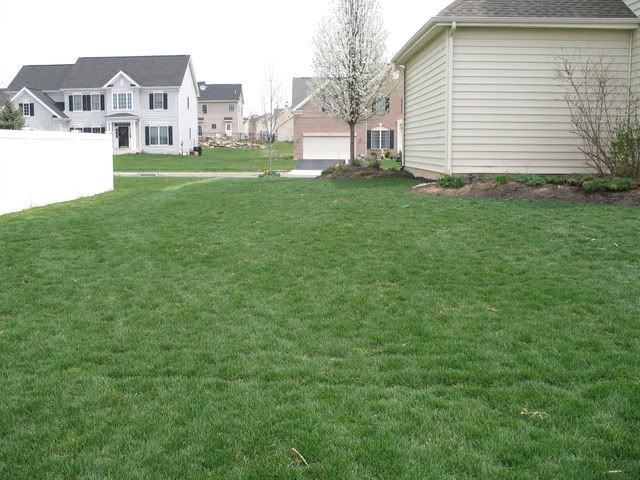 Here's an updated image from today. The color is greening, although density is still increasing only very slowly.
Here's an updated image from today. The color is greening, although density is still increasing only very slowly.
As always, click to embiggen any photo.
Bonus shots! Here's the back garden, plus two closeups:

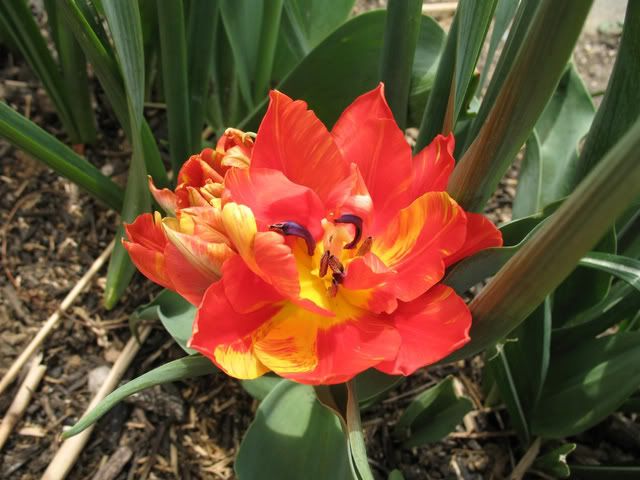
Tuesday, April 14, 2009
Fifteen Thuja standishii x plicata (Green Giant Thuja)
We'd like a bit more privacy on the back line, plus something that will stay evergreen and give a bit of wind protection. Thuja standishii x plicata, Thuja Green Giant, fit that bill perfectly. Our local nursery, Glenmar, promised 2 gallon, 2 foot plants. We got 2 gallon, 3 foot or taller plants, so I'm very pleased and the price was extremely reasonable at around $27 per shrub. Glenmar always has incredibly healthy plants and the prices are good.
Fifteen of those are now on the back line, one every five feet for a faster privacy screen and to limit their adult height and width. They shouldn't go taller than 20 feet, whereas a single specimen can get very wide and 40 feet tall.
For soil preparation, I used six small handfulls of corn meal mixed with a bit of alfalfa and a small amount of kelp meal in around thirty cubic feet of soil (per plant). That was mixed in to the soil and the holes were dug about 2' away from the bushes to give them a clear field with no competition. I didn't dig any deeper than the root mass to give them a solid base.
Advertising says they grow three to five feet per year, but that tends to be once they're established. Starting at 3 feet, I don't expect much more than six inches of growth this year, 18" next year, and then they should begin to grow quickly.
If you have questions about Thuja, visit the Bestlawn forum and use the Around the Yard section. You can sign up for free, and they have people who know a lot more than I do.
Sunday, April 5, 2009
Certainty on P. annua (Annual Bluegrass) and More
I sprayed Certainty at the recommended rate of 0.75 ounces per acre (although I spot-sprayed) on some P. annua (annual bluegrass) in the lawn. We'll see how that works--I'd rather not take out the patches with Round Up as they're very small and mixed in with the rest of the bluegrass.
I also applied 150 pounds of soybean meal to the lawn today, for about 1.5 lbs of N per thousand, 0.2 lbs of P, and 0.4 lbs of K. This will probably be the only feeding in April, and this won't be available to the lawn until April 25th or so.
Wednesday, April 1, 2009
Does Corn Meal On The Lawn Really Work?
I found this search term in my logs and I was intrigued by the question. The short answer is: yes.
The longer answer is that it depends on what you're doing.
For fungal control, 10 to 20 pounds per thousand square feet are sufficient. Corn meal attracts trichoderma fungus, This fungus takes up space in the soil, giving your invading fungus less room to grow. It also has the ability to kill other fungi, which is a major advantage when fighting a fungus problem in your lawn. However, for severe infections chemical controls may be called for.
For soil conditioning, anything from 10 to about 60 pounds per thousand is fine. Your worms like to eat fungi and bacteria, and the corn meal will grow those in spades. Additionally, bacteria and fungi themselves help condition your soil by attaching soil particles together using glomalin, increasing the soil's structure.
For feeding the lawn I wouldn't use corn meal. Granted, organics don't feed the lawn directly, however there are higher protein (nitrogen) meals available such as soybean that don't require the amounts that corn meal does. Additionally, corn meal doesn't contain large amounts of phosphorous or potassium, making it a less effective fertilizer overall. Sixty pounds of corn meal per thousand square feet would be required four times yearly to feed the lawn. By comparison, fourteen pounds per thousand square feet of soybean meal four times a year will feed the lawn at the same level.
For smaller fungal outbreaks you can use the corn meal from the grocery store. For general soil additives, purchasing the corn meal from your local feed mill is far more cost-effective.
Cracked corn will work just as well, although you may notice birds feeding on it.
We discuss a lot of these issues over at Bestlawn and you can read all the forums without signing up. However, signup is free, they never send unrequested e-mail, and everybody is very helpful with lawn questions.
Tuesday, March 31, 2009
Another Photo!
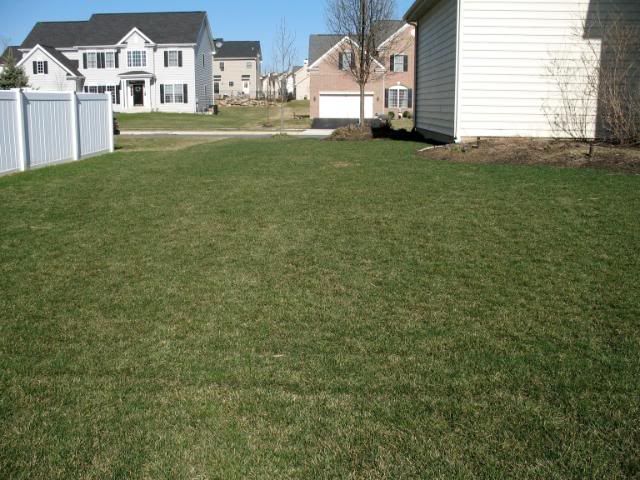
As always, click to embiggen. This shot is from today, March 31, 2009. The color is starting to deepen and the density is slowly increasing. If you look very closely, you'll see a few minor problem areas that I've now core aerated. I'd already reseeded those over the winter and they should be sprouting sometime soon.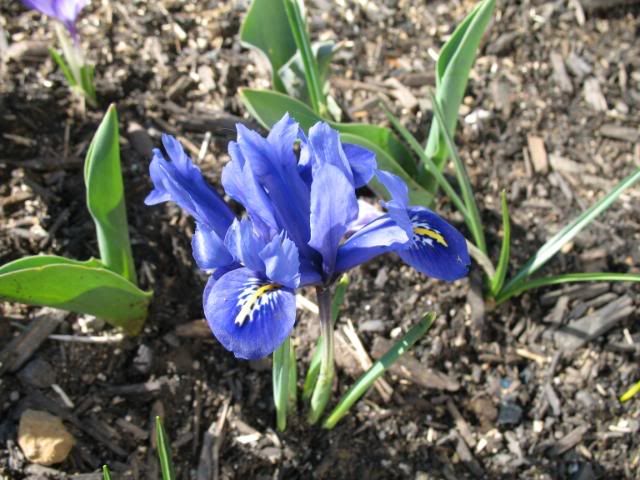 Bonus shot! Here's a blue blooming Iris Reticulata.
Bonus shot! Here's a blue blooming Iris Reticulata.
Sunday, March 29, 2009
Soil Testing
I'm sending off soil tests to U. Mass Amherst, but I also have a small and very basic sample kit of my own from Rapid Test.
The pH tested at 6.5 (see below), and I'm pending on the other tests waiting for the soil mix to settle. That could be 24 hours, so I'll update this later. (Later: N is testing as deficient, which is no surprise on an organic lawn. P tests as sufficient. K is testing as surplus).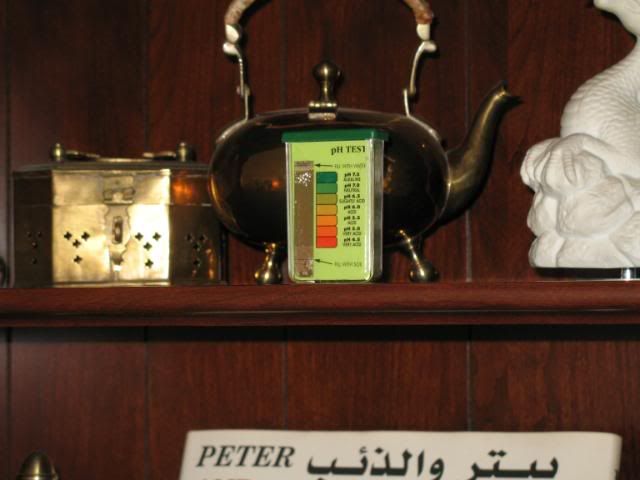 Here's the pH test. I'm calling it 6.5, give or take a little. If that's correct, it's nearly perfect.
Here's the pH test. I'm calling it 6.5, give or take a little. If that's correct, it's nearly perfect.
 Here's the mixed soil sample (disgusting!) Make sure to use a cheap blender
Here's the mixed soil sample (disgusting!) Make sure to use a cheap blender
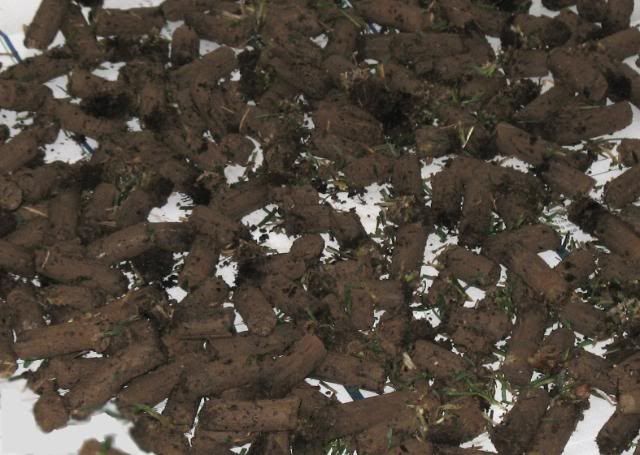 And here are the soil cores for U. Mass Amherst.
And here are the soil cores for U. Mass Amherst.
Friday, March 27, 2009
Kelp on the Lawn and Gardens
I just put down 10 pounds per thousand square feet of kelp meal on the lawn and gardens. Using a standard of 1-0-2, that's around 0.1 lbs nitrogen, no phosphorus, and 0.2 lbs of potassium. However, kelp generally isn't used for its NPK supply and functions far better as a soil conditioner.
Kelp contains auxins, cytokinins, and gibberelins, which encourage the roots to grow as well. That will help in both the lawn and gardens and assist in restoring more of the grub damage they sustained last fall.
Saturday, March 21, 2009
More Corn Meal
I bought 7 more bags of corn meal, six for the lawn and 1 for the gardens. That went down today.
One note that I have is not to purchase the fine-ground stuff in the future. I had to put that down by hand, whereas the rougher ground will go through my spreader. Doing it by hand took four hours.
Well, at least it's complete! That's now 83 pounds of corn meal per thousand (about eight times normal), or enough to condition the soil through spring. If I add any in May, I'll probably go with cracked corn. Right now, I have some very happy earthworms who will hopefully have more earthworms...
Tuesday, March 17, 2009
Corn Meal and the Lawn
200 pounds of corn meal went down today, and I'm starting to account for the area that will end up being planted with Thuja come April. As of now, I'm using a typical standard of 6,000 square feet of lawn, figuring that about 1,000 will either be under or behind the new bushes and I won't want to feed it because I don't want it to grow that much.
So that works out to 33.3 pounds per thousand, about half what I'd like to add (but I could only get 4 bags and will need to go for four more). Corn meal is mostly a soil conditioner, or used to combat fungal issues, which I don't have. I'm looking to deepen the topsoil more, however, and for that it works well and can be put down in very large amounts as it has few resources. I use a standard NPK of 1.65-0.65-0.40 for that, a far cry from soybean's 7-1-2.
Monday, March 16, 2009
Updated (Late) Image and Mowing
The lawn went through first mow yesterday, taking it down to 1 1/2" to get rid of the dead tips and expose the soil to a little more sun. It's greener, and the weather looks to hold in the forties and fifties this week so it should green up even more.
I took a reference photo of the bluegrass back in February but neglected to post it--whoops! Here it is now. As always, click to embiggen.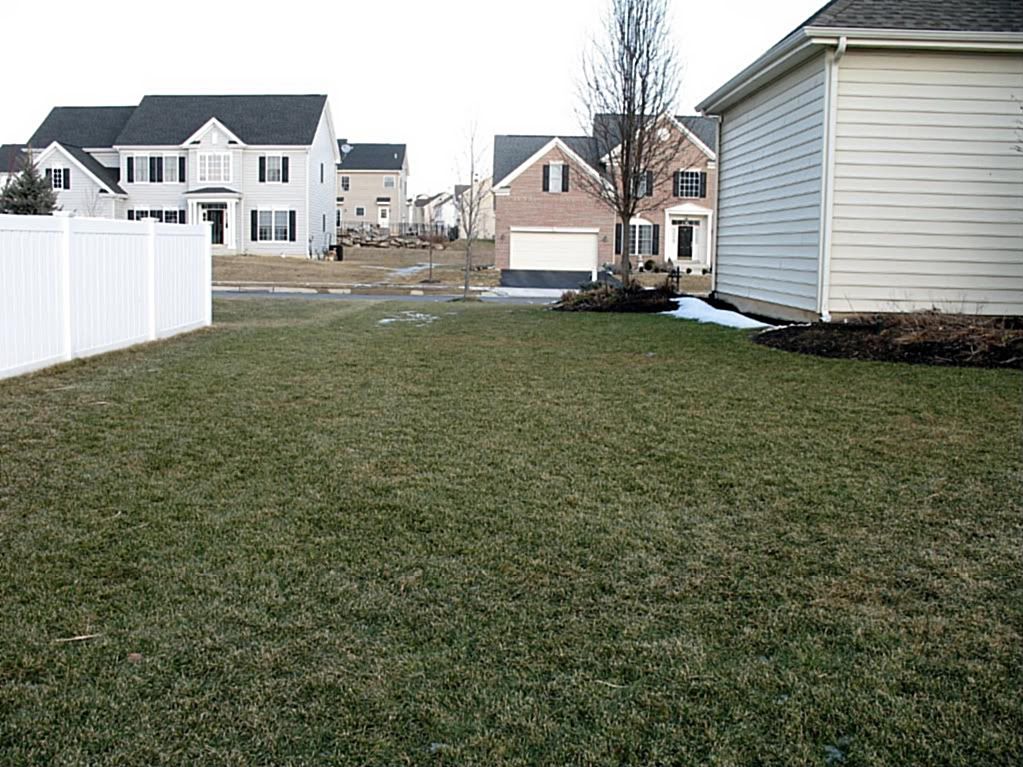
Saturday, March 14, 2009
Alfalfa On The Lawn
I distributed 100 lbs of alfalfa meal on the lawn today, for about 14 pounds per thousand square feet. I usually use a standard of 2.5 - 1 - 2 (NPK) for that, so it adds up to around 0.35 lbs of nitrogen, 0.14 phosphorous, and 0.29 of potassium.
It has the advantage of containing tricontanol (a growth hormone) as well, so the roots will respond to it very well. After some issues with grubs last year, any response I can get on the roots would be very good.
This already has my total organics near 85 pounds per thousand this year. That's quite high.
I also planted a second Double Knockout rose bush as the first one flowered after only a month in the soil and kept flowering until it froze. I added several handfuls of alfalfa meal to the soil--roses love it--and fed the older bush as well.
Saturday, March 7, 2009
Several Tasks
I moved a rose bush today to prepare for the new shrubs on the back line. That, at least, was fairly easy!
The lawn saw another treatment with Nature's Magic and Aerify since the weather was a very nice seventy. I also applied a small amount of Sul-Po-Mag to get 1/3 of a pound of potassium down.
Deinflation is Grand
I stopped out at Albright's Mill in Kempton today for soybean meal (and corn meal for some new shrubs). Last year's price was $13.25, this year's was $10.97. If I'm doing the math right, it went down 17%!
Saturday, February 28, 2009
Milorganite and Purchases
The grass is starting to awaken very slightly (so of course we'll be getting 2 to 4 inches of snow tomorrow). I put down 144 lbs of Milorganite as a feeding now that the dog food has been consumed by the birds and worms.
I ordered 200 lbs of kelp meal from Dirt Works for $258 including shipping. That's a bit expensive, but I can't get it locally and that's enough for the whole year. I also bought a second EZ Flo system from Dripworks and a 50 pound bag of Sul-Po-Mag from Planet Natural. That should take care of most of my needs for the year as far as extras go. Other than that, the plan is for soybean meal in April, May, June, August, and September, and Milorganite in July and October.
Saturday, February 21, 2009
Liming the Lawn
Well, the weather's fair for late February, if you can call 38° fair. At least it's sunny.
I picked up four bags of dolomitic limestone (about 20% calcium and 10% magnesium) today at Lowe's for about $4 each--I spend a bit more for the pelletized. That gets 22 lbs per thousand square feet down, which is about 4 pounds of calcium and 2 pounds of magnesium per thousand.
That should only be enough to move the pH of the soil about a tenth of a point, so I won't worry about it. Since I'm sitting at a near-perfect pH of 6.8, I have no desire to shift it around at all.
I also took the opportunity to drop 18 lbs per thousand square feet of Milorganite on the gardens so they have something to work with as spring starts up (shortly! I already have 200 sprouting early bulbs).
Monday, February 16, 2009
Last Year's Totals
I took the record of last year's totals, including what I did, and included it below for your perusal. Please note that my totals are very high as I'm trying to transform very poor subsurface clay into a decent environment.
For the columns the amounts are pounds per thousand square feet. N, P, and K are calculated off the item put down and the pounds used.
Only the total organic amount at the bottom (over a ton!) is the complete amount added.
I tend to use 2-1-2 (N-P-K) for Alfalfa, 7-1-2 for Soybean Meal, 5-2-0 (from the bag) for Milorganite, and 1-0-2 for Kelp Meal. Lime provides no nutrients, per se, but does release calcium and magnesium (I use dolomitic lime) over time.
| Date | N | P | K | Organics | Iron | Other Notes |
| 3/1/2008 | 0.39 | 0.16 | 0.31 | 15.7 |
| Alfalfa |
| 3/14/2008 | 0.12 | 0.00 | 0.22 | 11.5 |
| Kelp meal |
| 3/26/2008 | 1.20 | 0.40 | 0.00 | 20.0 | 0.80 | Milorganite |
| 4/10/2008 | 0.50 | 0.07 | 0.14 | 7.1 |
| Soybean meal |
| 4/19/2008 | 0.76 | 0.17 | 0.14 | 12.3 | 0.21 | Soybean, Milorganite, lime |
| 4/24/2008 | 1.50 | 0.21 | 0.43 | 21.4 |
| Soybean meal |
| 5/3/2008 | 0.25 | 0.10 | 0.00 | 5.0 | 0.20 | Milorganite |
| 5/7/2008 | 0.26 | 0.10 | 0.00 | 5.1 | 0.21 | Milorganite |
| 5/23/2008 | 1.48 | 0.59 | 0.00 | 29.5 | 1.18 | Milorganite |
| 6/7/2008 | 0.40 | 0.06 | 0.11 | 5.7 |
| Soybean meal |
| 6/21/2008 | 0.60 | 0.09 | 0.17 | 8.6 |
| Soybean meal |
| 7/4/2008 | 0.51 | 0.21 | 0.00 | 10.3 | 0.41 | Milorganite |
| 7/19/2008 | 0.51 | 0.21 | 0.00 | 10.3 | 0.41 | Milorganite |
| 7/26/2008 | 0.24 | 0.06 | 0.16 | 0 |
| Miracle Gro, lime |
| 8/2/2008 | 1.00 | 0.14 | 0.29 | 14.3 |
| Soybean meal |
| 8/4/2008 | 0.17 | 0.07 | 0.13 | 6.7 |
| Alfalfa |
| 8/16/2008 | 1.00 | 0.14 | 0.29 | 14.3 |
| Soybean meal |
| 8/27/2008 | 1.00 | 0.14 | 0.29 | 14.3 |
| Soybean meal |
| 8/31/2008 | 0.26 | 0.10 | 0.00 | 5.1 | 0.21 | Milorganite |
| 9/10/2008 | 1.00 | 0.14 | 0.29 | 14.3 |
| Soybean meal |
| 9/24/2008 | 1.00 | 0.14 | 0.29 | 14.3 |
| Soybean meal |
| 10/4/2008 | 1.00 | 0.41 | 0.00 | 20.6 | 0.82 | Milorganite |
| 10/12/2008 | 0.50 | 0.20 | 0.00 | 10.3 | 0.41 | Milorganite |
| 10/18/2008 | 0.50 | 0.20 | 0.00 | 10.3 | 0.41 | Milorganite |
| 11/1/2008 | 1.00 | 0.41 | 0.00 | 20.6 | 0.82 | Milorganite |
| 11/14/2008 | 1.05 | 0.10 | 0.67 | 0.0 |
| Winterizer |
|
|
|
|
|
|
|
|
| Total per K ft: | 18.20 | 4.62 | 3.90 | 307.6 | 6.09 | 2153 active organic total |
